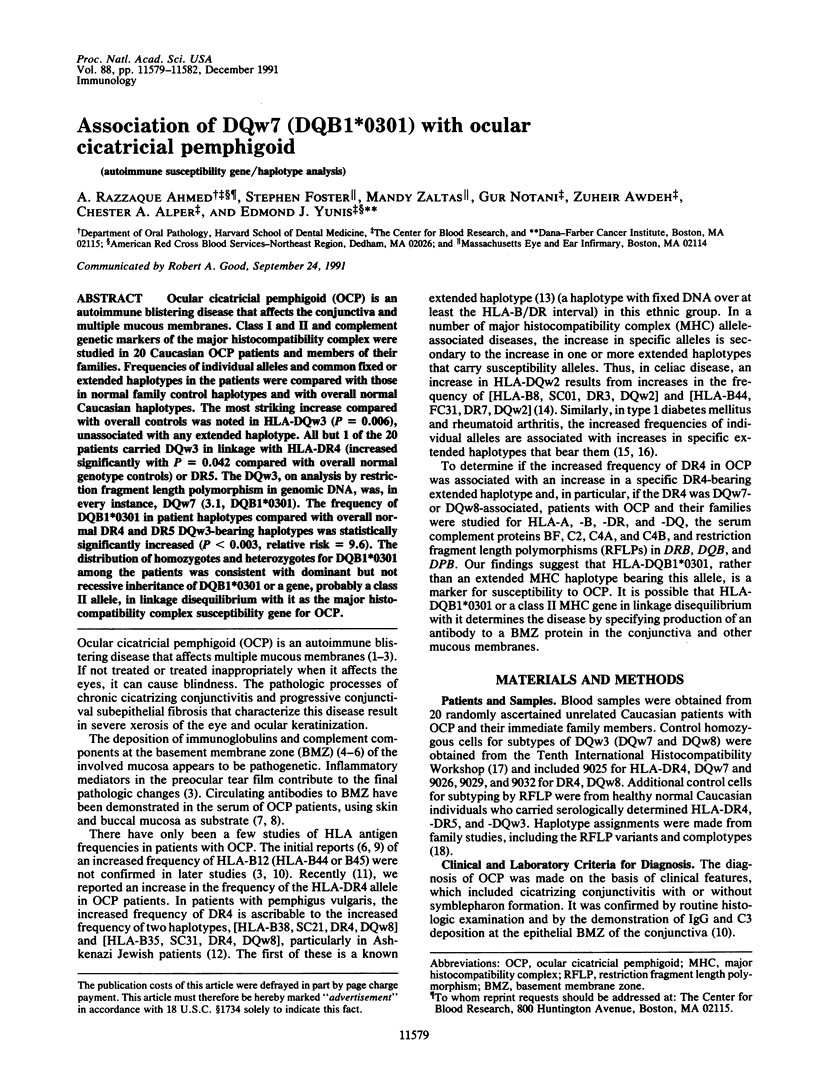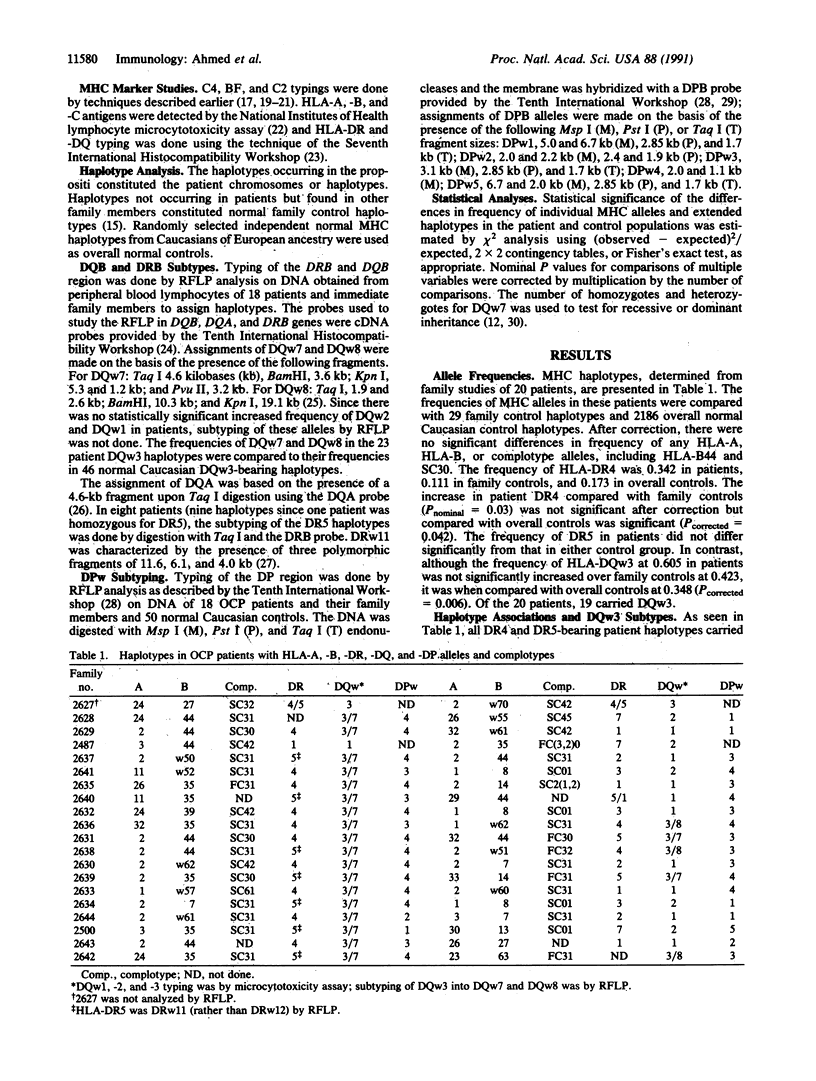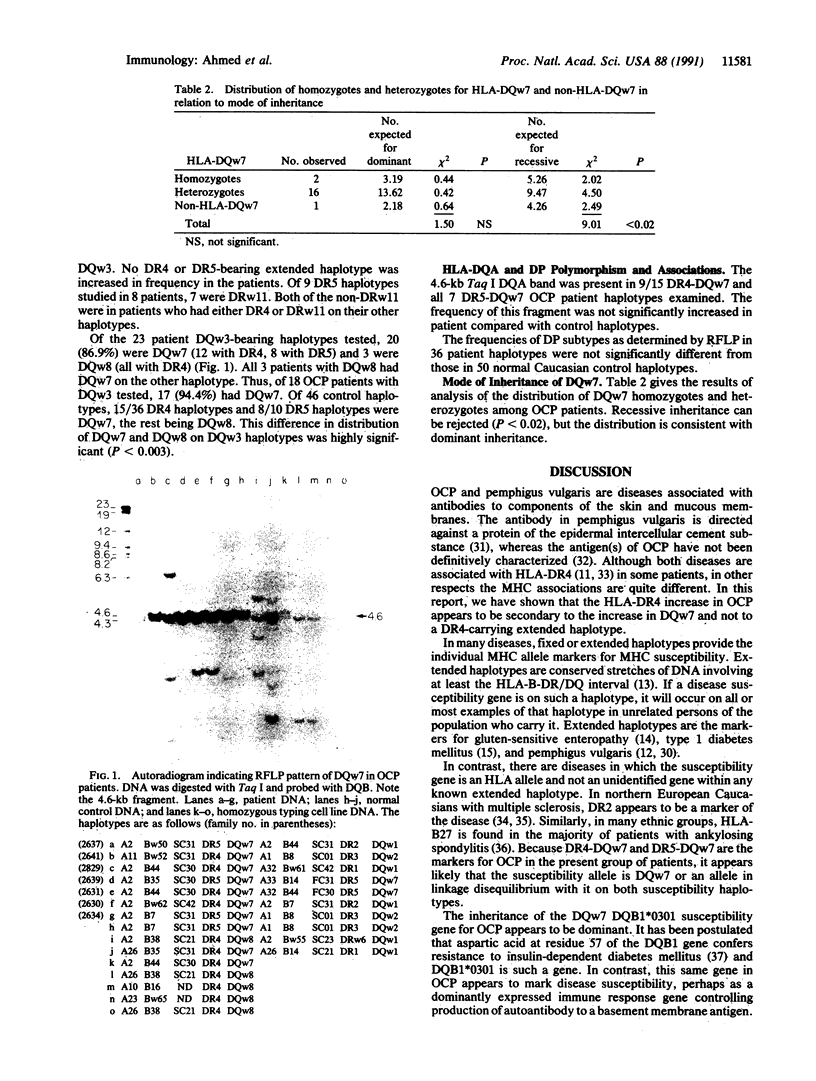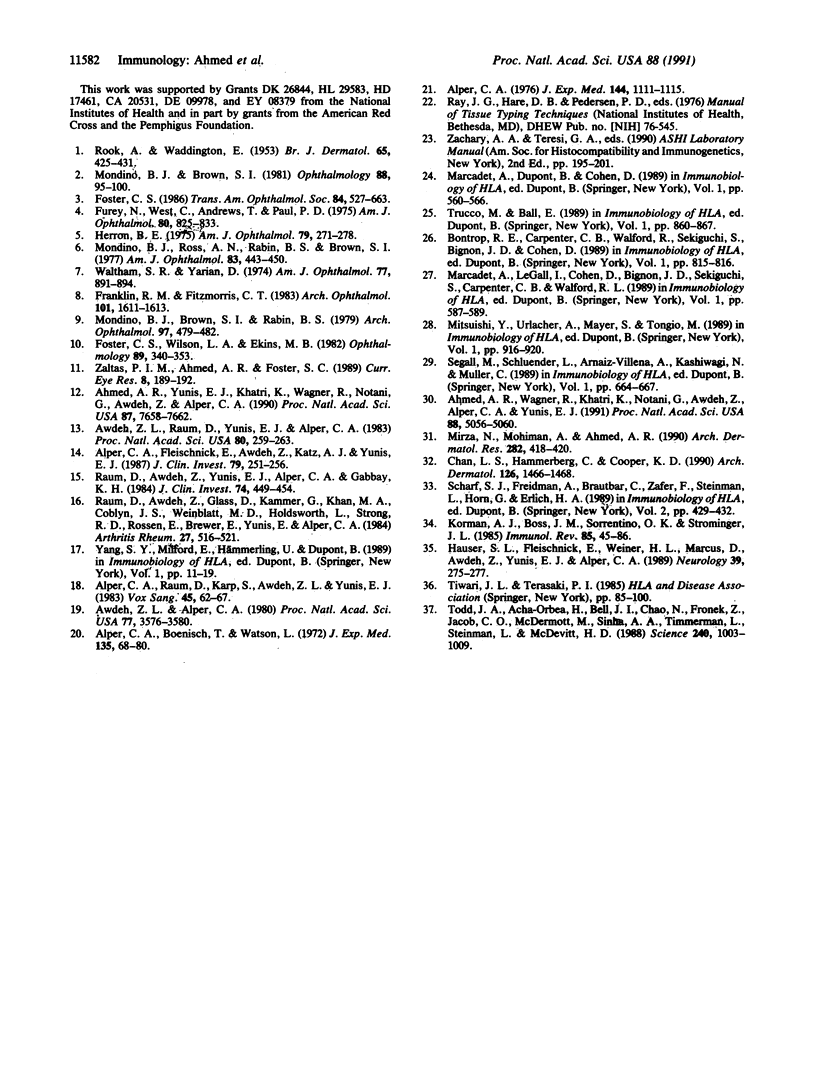Abstract
Ocular cicatricial pemphigoid (OCP) is an autoimmune blistering disease that affects the conjunctiva and multiple mucous membranes. Class I and II and complement genetic markers of the major histocompatibility complex were studied in 20 Caucasian OCP patients and members of their families. Frequencies of individual alleles and common fixed or extended haplotypes in the patients were compared with those in normal family control haplotypes and with overall normal Caucasian haplotypes. The most striking increase compared with overall controls was noted in HLA-DQw3 (P = 0.006), unassociated with any extended haplotype. All but 1 of the 20 patients carried DQw3 in linkage with HLA-DR4 (increased significantly with P = 0.042 compared with overall normal genotype controls) or DR5. The DQw3, on analysis by restriction fragment length polymorphism in genomic DNA, was, in every instance, DQw7 (3.1, DQB1*0301). The frequency of DQB1*0301 in patient haplotypes compared with overall normal DR4 and DR5 DQw3-bearing haplotypes was statistically significantly increased (P less than 0.003, relative risk = 9.6). The distribution of homozygotes and heterozygotes for DQB1*0301 among the patients was consistent with dominant but not recessive inheritance of DQB1*0301 or a gene, probably a class II allele, in linkage disequilibrium with it as the major histocompatibility complex susceptibility gene for OCP.
Full text
PDF



Images in this article
Selected References
These references are in PubMed. This may not be the complete list of references from this article.
- Ahmed A. R., Wagner R., Khatri K., Notani G., Awdeh Z., Alper C. A., Yunis E. J. Major histocompatibility complex haplotypes and class II genes in non-Jewish patients with pemphigus vulgaris. Proc Natl Acad Sci U S A. 1991 Jun 1;88(11):5056–5060. doi: 10.1073/pnas.88.11.5056. [DOI] [PMC free article] [PubMed] [Google Scholar]
- Ahmed A. R., Yunis E. J., Khatri K., Wagner R., Notani G., Awdeh Z., Alper C. A. Major histocompatibility complex haplotype studies in Ashkenazi Jewish patients with pemphigus vulgaris. Proc Natl Acad Sci U S A. 1990 Oct;87(19):7658–7662. doi: 10.1073/pnas.87.19.7658. [DOI] [PMC free article] [PubMed] [Google Scholar]
- Alper C. A., Boenisch T., Watson L. Genetic polymorphism in human glycine-rich beta-glycoprotein. J Exp Med. 1972 Jan;135(1):68–80. doi: 10.1084/jem.135.1.68. [DOI] [PMC free article] [PubMed] [Google Scholar]
- Alper C. A., Fleischnick E., Awdeh Z., Katz A. J., Yunis E. J. Extended major histocompatibility complex haplotypes in patients with gluten-sensitive enteropathy. J Clin Invest. 1987 Jan;79(1):251–256. doi: 10.1172/JCI112791. [DOI] [PMC free article] [PubMed] [Google Scholar]
- Alper C. A. Inherited structural polymorphism in human C2: evidence for genetic linkage between C2 and Bf. J Exp Med. 1976 Oct 1;144(4):1111–1115. doi: 10.1084/jem.144.4.1111. [DOI] [PMC free article] [PubMed] [Google Scholar]
- Alper C. A., Raum D., Karp S., Awdeh Z. L., Yunis E. J. Serum complement 'supergenes' of the major histocompatibility complex in man (complotypes). Vox Sang. 1983;45(1):62–67. doi: 10.1111/j.1423-0410.1983.tb04124.x. [DOI] [PubMed] [Google Scholar]
- Awdeh Z. L., Alper C. A. Inherited structural polymorphism of the fourth component of human complement. Proc Natl Acad Sci U S A. 1980 Jun;77(6):3576–3580. doi: 10.1073/pnas.77.6.3576. [DOI] [PMC free article] [PubMed] [Google Scholar]
- Awdeh Z. L., Raum D., Yunis E. J., Alper C. A. Extended HLA/complement allele haplotypes: evidence for T/t-like complex in man. Proc Natl Acad Sci U S A. 1983 Jan;80(1):259–263. doi: 10.1073/pnas.80.1.259. [DOI] [PMC free article] [PubMed] [Google Scholar]
- Chan L. S., Hammerberg C., Cooper K. D. Cicatricial pemphigoid. Identification of two distinct sets of epidermal antigens by IgA and IgG class circulating autoantibodies. Arch Dermatol. 1990 Nov;126(11):1466–1468. doi: 10.1001/archderm.126.11.1466. [DOI] [PubMed] [Google Scholar]
- Foster C. S. Cicatricial pemphigoid. Trans Am Ophthalmol Soc. 1986;84:527–663. [PMC free article] [PubMed] [Google Scholar]
- Foster C. S., Wilson L. A., Ekins M. B. Immunosuppressive therapy for progressive ocular cicatricial pemphigoid. Ophthalmology. 1982 Apr;89(4):340–353. doi: 10.1016/s0161-6420(82)34791-0. [DOI] [PubMed] [Google Scholar]
- Franklin R. M., Fitzmorris C. T. Antibodies against conjunctival basement membrane zone. Occurrence in cicatricial pemphigoid. Arch Ophthalmol. 1983 Oct;101(10):1611–1613. doi: 10.1001/archopht.1983.01040020613023. [DOI] [PubMed] [Google Scholar]
- Hauser S. L., Fleischnick E., Weiner H. L., Marcus D., Awdeh Z., Yunis E. J., Alper C. A. Extended major histocompatibility complex haplotypes in patients with multiple sclerosis. Neurology. 1989 Feb;39(2 Pt 1):275–277. doi: 10.1212/wnl.39.2.275. [DOI] [PubMed] [Google Scholar]
- Korman A. J., Boss J. M., Spies T., Sorrentino R., Okada K., Strominger J. L. Genetic complexity and expression of human class II histocompatibility antigens. Immunol Rev. 1985 Jul;85:45–86. doi: 10.1111/j.1600-065x.1985.tb01130.x. [DOI] [PubMed] [Google Scholar]
- Mirza N. M., Mohimen A., Ahmed A. R. Detection of pemphigus vulgaris antigen on COLO and SCaBER tumor cell lines by the immunoblot technique. Arch Dermatol Res. 1990;282(6):418–420. doi: 10.1007/BF00372096. [DOI] [PubMed] [Google Scholar]
- Mondino B. J., Brown S. I. Ocular cicatricial pemphigoid. Ophthalmology. 1981 Feb;88(2):95–100. doi: 10.1016/s0161-6420(81)35069-6. [DOI] [PubMed] [Google Scholar]
- Mondino B. J., Brown S. I., Rabin B. S. HLA antigens in ocular cicatricial pemphigoid. Arch Ophthalmol. 1979 Mar;97(3):479–479. doi: 10.1001/archopht.1979.01020010229007. [DOI] [PubMed] [Google Scholar]
- Mondino B. J., Ross A. N., Rabin B. S., Brown S. I. Autoimmune phenomena in ocular cicatricial pemphigoid. Am J Ophthalmol. 1977 Apr;83(4):443–450. doi: 10.1016/0002-9394(77)90546-3. [DOI] [PubMed] [Google Scholar]
- Raum D., Awdeh Z., Glass D., Kammer G., Khan M. A., Coblyn J. S., Weinblatt M., Holdsworth D., Strong L., Rossen R. D. Extended haplotypes of chromosome 6 in adult rheumatoid arthritis. Arthritis Rheum. 1984 May;27(5):516–521. doi: 10.1002/art.1780270506. [DOI] [PubMed] [Google Scholar]
- Raum D., Awdeh Z., Yunis E. J., Alper C. A., Gabbay K. H. Extended major histocompatibility complex haplotypes in type I diabetes mellitus. J Clin Invest. 1984 Aug;74(2):449–454. doi: 10.1172/JCI111441. [DOI] [PMC free article] [PubMed] [Google Scholar]
- Todd J. A., Acha-Orbea H., Bell J. I., Chao N., Fronek Z., Jacob C. O., McDermott M., Sinha A. A., Timmerman L., Steinman L. A molecular basis for MHC class II--associated autoimmunity. Science. 1988 May 20;240(4855):1003–1009. doi: 10.1126/science.3368786. [DOI] [PubMed] [Google Scholar]
- WADDINGTON E. Pemphigus and pemphigoid. Br J Dermatol. 1953 Dec;65(12):425–431. doi: 10.1111/j.1365-2133.1953.tb13181.x. [DOI] [PubMed] [Google Scholar]
- Waltman S. R., Yarian D. Circulating autoantibodies in ocular pemphigoid. Am J Ophthalmol. 1974 Jun;77(6):891–894. doi: 10.1016/0002-9394(74)90394-8. [DOI] [PubMed] [Google Scholar]
- Zaltas M. M., Ahmed R., Foster C. S. Association of HLA-DR4 with ocular cicatricial pemphigoid. Curr Eye Res. 1989 Feb;8(2):189–193. doi: 10.3109/02713688908995191. [DOI] [PubMed] [Google Scholar]



